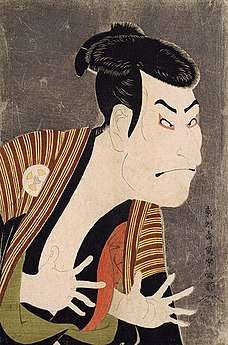Bijin-ga
Bijin-ga (
| Three Beauties of the Present Day by Utamaro, 1793 | |
|---|---|
_Three_Beauties_of_the_Present_Time%2C_MFAB_21.6382.jpg) | |
| Artist | Kitagawa Utamaro |
| Year | 1793 |
Ukiyo-e is a genre of woodblock prints and paintings that was produced in Japan from the 17th century to the 19th century. These woodblock prints depicted beautiful women; kabuki actors and sumo wrestlers; scenes from history and folk tales; travel scenes and landscapes; flowers and animals and erotica. The prints were very popular amongst the Japanese merchants and the middle class of the time.
Nearly all ukiyo-e artists produced bijin-ga, it being one of the central themes of the genre. However, a few, including Utamaro, Suzuki Harunobu, Itō Shinsui, Toyohara Chikanobu, Uemura Shōen and Torii Kiyonaga, have been described as the greatest innovators and masters of the form.
Gallery
- Bijin-ga
 Bijin-ga by Keisai Eisen (1790–1848)
Bijin-ga by Keisai Eisen (1790–1848)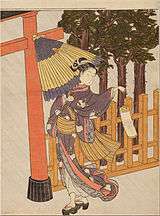 Woman Visiting the Shrine in the Night by Suzuki Harunobu (1725–1770)
Woman Visiting the Shrine in the Night by Suzuki Harunobu (1725–1770) Shin Bijin, Shin Bijin series, No. 12 by Yōshū Chikanobu (1838–1912)
Shin Bijin, Shin Bijin series, No. 12 by Yōshū Chikanobu (1838–1912)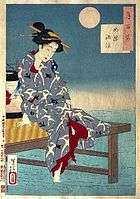 100 Aspects of the Moon by Yoshitoshi (1839–1892)
100 Aspects of the Moon by Yoshitoshi (1839–1892)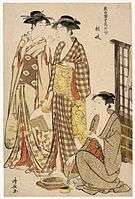 Two Women Standing from series "Tosai Yuri Bijin Awase", by Torii Kiyonaga (1752–1815)
Two Women Standing from series "Tosai Yuri Bijin Awase", by Torii Kiyonaga (1752–1815)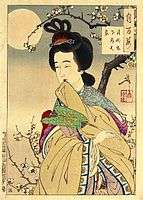 Woman with cherry flowers by Tsukioka Yoshitoshi
Woman with cherry flowers by Tsukioka Yoshitoshi A Girl About to Despatch a Letter, by Torii Kiyomine (1786–1868)
A Girl About to Despatch a Letter, by Torii Kiyomine (1786–1868) The Courtesan Someyama of the Matsubaya house, from the series: Contest of Beauties in the Gay Quarters, by Eishosai Choki - active from about 1786 to 1808.
The Courtesan Someyama of the Matsubaya house, from the series: Contest of Beauties in the Gay Quarters, by Eishosai Choki - active from about 1786 to 1808.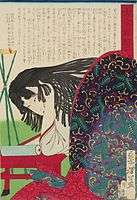 Murasaki Shikibu, from the series "Mirror of Women, Ancient and Modern" (古今姫鏡), by Tsukioka Yoshitoshi (1839–1892)
Murasaki Shikibu, from the series "Mirror of Women, Ancient and Modern" (古今姫鏡), by Tsukioka Yoshitoshi (1839–1892)
- Woman in the night, by Suzuki Harunobu, c. 1765–1770
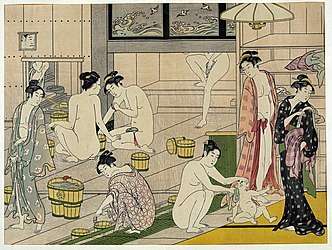 Bathhouse women, by Torii Kiyonaga (1752–1815)
Bathhouse women, by Torii Kiyonaga (1752–1815)
See also
- Bijin
- Bihaku
Further reading
- Forbes, Andrew ; Henley, David (2012). Suzuki Harunobu: 100 Beauties. Chiang Mai: Cognoscenti Books. ASIN: B00AC2NB8Y
- Hamanaka, Shinji. Female Image: 20th Century Prints of Japanese Beauties. Hotei Publishing 2000. ISBN 90-74822-20-7
